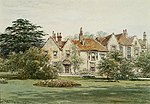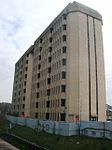Edwardes Place
KensingtonShand familyStreets in the Royal Borough of Kensington and Chelsea

1-5 Edwardes Place is a grade II listed terrace of five houses set back from but facing Kensington High Street, with the road into Edwardes Square running alongside no.1, with the similar but longer Earl's Terrace on the other side.The terrace was laid out and built from 1810 to 1819.The entire terrace was acquired by Hugh Morton Shand (1815–1890), British army officer and businessman.Alexander Faulkner Shand (1858–1936), the writer and barrister, and patrilineal great-grandfather of Queen Camilla, lived at no. 1.The terrace was grade II listed in 1969.
Excerpt from the Wikipedia article Edwardes Place (License: CC BY-SA 3.0, Authors, Images).Edwardes Place
Avonmore Road, London West Kensington (London Borough of Hammersmith and Fulham)
Geographical coordinates (GPS) Address Nearby Places Show on map
Geographical coordinates (GPS)
| Latitude | Longitude |
|---|---|
| N 51.4952 ° | E -0.2047 ° |
Address
Gilbert Scott House
Avonmore Road 3
W14 8RU London, West Kensington (London Borough of Hammersmith and Fulham)
England, United Kingdom
Open on Google Maps









